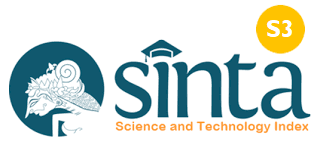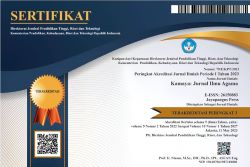Fenomena Flexing Culture Di Media Sosial Mahasiswa Pendidikan Agama Islam
Perspektif Krisis Pendidikan Islam
DOI:
https://doi.org/10.37329/kamaya.v7i3.3567Keywords:
Flexing Culture, Social Media, Islamic Education CrisisAbstract
Islamic Religious Education students as future religious educators need to realize the importance of limiting the content shared on social media to maintain integrity and ethics in accordance with Islamic values. This is to keep activities on social media reasonable and not contradict their role as role models in society. This study aims to describe the motives of flexing culture of Islamic Education students at IAIN Palangka Raya on social media and find out how the phenomenon of flexing culture on social media of Islamic Education students according to the perspective of the Islamic Education crisis. The method used in this research is a qualitative approach using descriptive data. This research uses data collection techniques in the form of interviews and documentation, which are analyzed through data reduction, data presentation, and conclusion drawing. The results showed that the main motive of Islamic Religious Education students class 2020 class A semester 8 IAIN Palangka Raya behind this flexing culture is from internal encouragement, the phenomenon of flexing culture among Islamic Education students has two different sides in the context of the Islamic Education crisis. On the one hand, sharing academic achievements and positive activities can motivate and build a good self-image. However, if done with the intention to boast, this can reduce the quality of Islamic education and obscure religious values. There needs to be a higher awareness among Islamic Education students regarding the wise use of social media in order to avoid the potential for irritation, feelings of inferiority, and the development of negative perceptions among the community.
References
Adinda, K. (2023). Flexing di Instagram: Antara Narsisisme dan Benefit. Emik, 6(1), 68-90.
Ajahari. (2017). Studi Islam. Yogyakarta: Aswaja Pressindo.
Ali, M., SURTI, M., & WAHYUDI, D. (2019). Peran Pendidikan Agama Islam dalam Meningkatkan Daya Tahan Budaya Lokal Indonesia di Era Global. Tapis: Jurnal Penelitian Ilmiah, 3(2), 159-177.
Akhyak, M. A. (2009). Keluar dari Kemelut Krisis Pendidikan Islam (Ke arah Reformulasi Paradigma Filosofis) dalam Jurnal Terakreditasi Sosio Religia. Ilmu Agama dan Ilmu Sosial, 8(2), 477-496.
Hapsari, R., & Azahra, Z. (2020). Media Sosial Twitter dalam Dimensi Self Disclosure pada Mahasiswa di Kota Depok. BroadComm, 2(2), 57-71.
Harianti, L. (2019). Personal Branding Pejabat Publik Di Media Sosial (Studi Deskriptif Kualitatif Personal Branding Harnojoyo Melalui Akun Instagram Pribadi@ harno. joyo) (Doctoral dissertation, UIN Raden Fatah Palembang).
Husnah, Z. (2019). Etika Penggunaan Media Sosial dalam Al-Qur'an sebagai Alat Komunikasi Si Era Digitalisasi. Al-Mutsla, 1(2), 149-162.
Ihsan, F. (1996). Dasar-dasar Kependidikan. Jakarta: Rineka Cipta.
Jean M., T. (2006). Generation Me: Why today’s Young Americans Are More Confident, Assertive, Entitled And More Miserable Than Ever Before. United States of America: Free Press
Khobir, A. (2009). Pendidikan Agama Islam Di Era Globalisasi. In Forum Tarbiyah (Vol. 7, No. 1).
Laana, D. L., & Sukri, U. (2022). Life style: Perilaku Mahasiswa Masa Kini Dan Pengaruh Media Sosial. Inculco Journal of Christian Education, 2(1), 67-80.
Mardiah, A. (2022, October). Fenomena Flexing: Pamer di Media Sosial dalam Persfektif Etika Islam. In Proceeding International Conference on Tradition and Religious Studies (Vol. 1, No. 1, pp. 309-319).
Marzuki, M. E. (2023). Fenomena Budaya Flexing Lesti–Bilar dalam Relasinya dengan Imitative Materialistis. Jurnal Ilmiah Multimedia dan Komunikasi, 8(2).
Nudin, B. (2020). Konsep Pendidikan Islam Pada Remaja di Era Disrupsi Dalam Mengatasi Krisis Moral. Literasi: Jurnal Ilmu Pendidikan, 11(1), 63-74.
Pratama, M. I., Rahman, A., & Bachmid, F. (2022). Kebebasan Berpendapat dan Berekspresi di Media Sosial dalam Perspektif Hak Asasi Manusia. Qawanin Jurnal Ilmu Hukum, 3(1), 1-16.
Reiss, S. (2004). Multifaceted Nature Of Intrinsic Motivation: The Theory Of 16 Basic Desires. Review of General Psychology, 8(3), 179-193.
Romlah, S., & Rusdi, R. (2023). Pendidikan Agama Islam Sebagai Pilar Pembentukan Moral Dan Etika. Al-Ibrah: Jurnal Pendidikan dan Keilmuan Islam, 8(1), 67-85.
Rosida, I., Zahra, F. A., Tuzzahrah, F., & Azzahra, S. (2023). Flexing culture In The Age Of Social Media: From Social Recognition To Self-Satisfaction. Simulacra, 6(2), 193-208.
Schivinski, B., Brzozowska-Woś, M., Stansbury, E., Satel, J., Montag, C., & Pontes, H. M. (2020). Exploring The Role Of Social Media Use Motives, Psychological Well-Being, Self-Esteem, And Affect In Problematic Social Media Use. Frontiers in Psychology, 11, 617140.
Sholeh, A. N. (2018). Panduan Menggunakan Media Sosial Untuk Generasi Emas Milenial. Jakarta: Kementerian Pemuda dan Olahraga
Yuhanidz, Y. (2024). Perilaku Flexing dalam Surah Al-Takatsur Perspektif Hamka dalam Tafsir Al-Azhar. El-Afkar: Jurnal Pemikiran Keislaman dan Tafsir Hadis, 13(1), 61-85.
Yulianti, P., Riadi, A., Zahratunnisa, F., Fatimah, N. A. A., & Arrahima, A. (2024). Kajian Literatur: Penggunaan Media Sosial Sebagai Sarana Dalam Meningkatkan Pembelajaran Pendidikan Agama Islam Pada Generasi Muda. Indonesian Journal of Islamic Education, 2(1), 113-123.
Zega, I. W., Purba, I. P. S. Br., Iqbal, M., Kurniawansah, Ainurridho, I., Madarusman, Y., Bachtiar, & Gueci, R. S., (2024). Penggunaan Media Sosial yang Bijak dalam Kebebasan Berekspresi dan Berpendapat. Abdi Laksana: Jurnal Pengabdian Kepada Masyarakat, 5(2), 498–504.
Downloads
Published
How to Cite
Issue
Section
License
Copyright (c) 2024 Kamaya: Jurnal Ilmu Agama

This work is licensed under a Creative Commons Attribution-ShareAlike 4.0 International License.
An author who publishes in the Kamaya : Jurnal Ilmu Agama agrees to the following terms:
- Author retains the copyright and grants the journal the right of first publication of the work simultaneously licensed under the Creative Commons Attribution-ShareAlike 4.0 License that allows others to share the work with an acknowledgement of the work's authorship and initial publication in this journal
- Author is able to enter into separate, additional contractual arrangements for the non-exclusive distribution of the journal's published version of the work (e.g., post it to an institutional repository or publish it in a book) with the acknowledgement of its initial publication in this journal.
- Author is permitted and encouraged to post his/her work online (e.g., in institutional repositories or on their website) prior to and during the submission process, as it can lead to productive exchanges, as well as earlier and greater citation of the published work (See The Effect of Open Access).
Read more about the Creative Commons Attribution-ShareAlike 4.0 Licence here: https://creativecommons.org/licenses/by-sa/4.0/.





